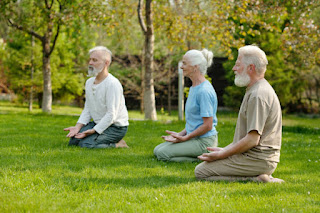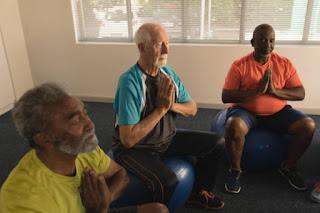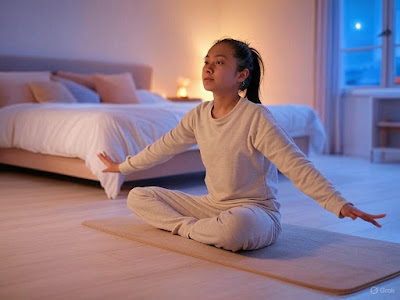Golden Years Mindfulness: Keeping the Aging Brain Sharp with Meditation
Mindful Aging: Using Meditation to Keep Your Brain Sharp in Later Years
As we age, maintaining cognitive health becomes increasingly important. While memory lapses, reduced focus, and emotional shifts are often seen as inevitable aspects of aging, there’s growing evidence that mindfulness and meditation can slow down these cognitive changes. For older adults, meditation offers a powerful tool to enhance memory, reduce cognitive decline, and improve emotional well-being. In this article, we’ll explore the scientific benefits of meditation on the aging brain, with a particular emphasis on guided imagery, mindful breathing, and other simple techniques. We’ll also offer tips for maintaining a meditation practice despite physical limitations, discuss how to join or start a meditation group, and provide resources for seniors living alone or in retirement communities.
The Science of Meditation and Cognitive Health in Aging
The brain undergoes several changes as we age, particularly in areas related to memory, learning, and emotional regulation. Research indicates that meditation can slow these changes and, in some cases, even reverse some effects of aging on the brain. For instance, a study published in Frontiers in Aging Neuroscience found that older adults who practiced mindfulness meditation exhibited greater preservation of gray matter in the brain regions associated with attention and memory. Moreover, meditation helps reduce stress, which is closely linked to memory loss and emotional instability.
One of the key ways meditation helps preserve brain health is by improving neuroplasticity. Neuroplasticity refers to the brain’s ability to reorganize itself by forming new neural connections throughout life. Meditation, particularly mindfulness meditation, encourages sustained focus and mental clarity, helping older adults enhance their cognitive functions like memory recall and attention span. Regular meditation also reduces levels of cortisol—the stress hormone that can accelerate brain aging and damage memory-related regions.
Deep Dive into Guided Imagery: Healing and Cognitive Support
Guided imagery, a form of meditation where one mentally visualizes calming scenes or positive scenarios, is particularly powerful for seniors. It engages multiple senses, triggering both the right and left hemispheres of the brain, enhancing memory, creativity, and problem-solving abilities. Studies have shown that guided imagery helps reduce cognitive decline by reinforcing neural pathways associated with imagination and memory.
In guided imagery, seniors can visualize peaceful environments such as a tranquil forest, a flowing river, or even favorite memories from their past. This process not only soothes the nervous system but also sharpens cognitive function, as the brain replays sensory details such as colors, sounds, and textures, activating the hippocampus and other memory-related areas.
Approaches to Guided Imagery Meditation
There are several ways older adults can integrate guided imagery into their mindfulness practice:
- Pre-recorded Sessions: Using apps or podcasts like the Powered by Joy Podcast, seniors can listen to pre-recorded guided imagery meditations. These sessions take the listener on a mental journey to peaceful places, which has been shown to reduce anxiety and stimulate cognitive engagement. Listening to a voice that describes every detail of a calming scene helps maintain focus while promoting relaxation.
- Personal Visualization: This technique allows older adults to craft their own mental landscapes based on personal experiences or favorite memories. A senior might mentally return to a cherished family vacation or a peaceful day in nature, revisiting the smells, sounds, and sights they remember. This personalized form of guided imagery creates a strong emotional and cognitive connection, strengthening memory recall.
- Therapeutic Imagery: For older adults dealing with emotional or physical challenges, guided imagery can also serve as a therapeutic tool. Visualizing healing, such as picturing the body repairing itself or feeling emotions being released, can ease stress and emotional discomfort while engaging the brain in proactive problem-solving.
Mindful Breathing: Simple Yet Effective
Mindful breathing is another meditation technique that provides cognitive and emotional benefits. By focusing on deep, controlled breaths, practitioners can reduce stress, increase concentration, and improve emotional balance. For older adults, mindful breathing is accessible and adaptable, making it a perfect starting point for a meditation routine.
One of the most effective breathing techniques for seniors is Nadi Shodhana, or alternate nostril breathing, which helps balance the brain hemispheres and calm the mind. Another is the 4-7-8 breathing method, which helps reduce anxiety by engaging the parasympathetic nervous system. Both methods can easily be adapted to suit physical limitations, as they can be practiced seated or even lying down.
Maintaining a Meditation Practice Despite Physical Limitations
Many older adults face physical challenges that can make sitting or moving for long periods difficult. However, meditation can be easily adapted to meet individual needs. Here are some practical tips for maintaining a meditation practice:
- Seated Meditation: Meditation can be done comfortably in a chair. Seniors can focus on maintaining good posture, keeping their feet grounded, and using deep breathing techniques to stay relaxed.
- Mindfulness During Daily Activities: For those who find sitting still uncomfortable, mindfulness can be practiced during everyday tasks like washing hands, walking, or eating. Bringing awareness to each action helps train the mind to stay focused, even during routine activities.
- Guided Audio Meditations: For those who find it hard to sit in stillness or who need additional guidance, listening to guided audio meditations can be helpful. Platforms like Calm and the Powered by Joy Podcast offer meditation sessions specifically tailored for seniors, focusing on relaxation, breath awareness, and imagery.
Scientific References and Resources on Meditation for Adults
To ensure the benefits of meditation are clear, it’s essential to turn to evidence-based sources. Here are a few key studies and resources that highlight meditation’s role in preserving cognitive health:
- Harvard Health Publishing – Discusses how mindfulness meditation helps slow cognitive decline and reduces stress-related damage in older adults.
- The American Psychological Association – Provides research findings on the neuroplasticity benefits of meditation, helping older adults retain cognitive functions longer.
- Frontiers in Aging Neuroscience – Published studies on how meditation helps preserve brain volume in seniors, focusing on areas like the hippocampus, which is vital for memory.
The Importance of Community: Starting or Joining Meditation Groups
Social engagement plays a crucial role in maintaining mental and emotional health, particularly in older adults. Meditation groups offer a unique way for seniors to connect with others, reduce feelings of loneliness, and share mindfulness practices. Being part of a meditation group not only enhances the sense of belonging but also strengthens emotional resilience and promotes mental well-being.
- Online Meditation Groups: For those unable to attend in-person sessions, many platforms offer online meditation classes specifically designed for seniors. These can be found on sites like Insight Timer, which offers community meditation groups accessible from home.
- Starting Your Own Group: Organizing a small meditation circle in a retirement community or assisted living center can be a great way to foster community and share the mental benefits of meditation. In my article “From Youth to Seniority: Meditation Practices Tailored for All Ages,” I emphasized the value of adapting meditation practices for older adults, highlighting how group practices can create bonds and foster mental well-being.
Meditation for Seniors in Retirement Communities and Assisted Living
For those living in assisted living or retirement communities, group meditation sessions can serve as a wonderful way to encourage mindfulness and cognitive engagement. Communities often offer wellness programs, and meditation can be an easy addition. For those who prefer individual practice, meditation apps and podcasts allow for guided sessions in the privacy of their own rooms.
For seniors living alone, meditation can provide a daily anchor, offering mental stimulation and emotional balance. Having a structured meditation routine can provide a sense of purpose, which is crucial for emotional and mental well-being.
A Lifelong Practice for Cognitive and Emotional Health
Meditation offers numerous benefits for older adults, from enhancing memory and reducing cognitive decline to improving emotional regulation. Techniques like guided imagery and mindful breathing are easy to incorporate into daily routines, and the practice can be adapted to meet individual physical needs. Whether practiced alone, in groups, or through online communities, meditation can provide seniors with the mental sharpness and emotional balance needed to navigate the golden years.
As I discussed in “First Steps into Silence: A Beginner’s Guide to Meditation,” meditation offers benefits at every stage of life, and its flexibility makes it accessible for everyone. As seniors embark on this journey, they’ll find that mindfulness is not just about sitting in silence—it’s about enhancing cognitive function, improving emotional well-being, and living with a greater sense of calm and purpose.









